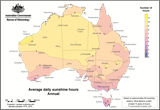Sun Lizard Solar Climate
Control -- How Effective Is It
In Heating Mode
Works when there is sunlight
|
The Sun
Lizard relies on the
sun. Its performance is directly related to how much
sun you get each day and will vary depending on
your location and solar radiation you receive. |
4–6C warmer
in winter |
If you have the Sun
Lizard installed and sized to your building correctly, you can
expect a 4 to 6 degrees warmer space in winter |
Recommended area:
100m2 for single collector
150m2 for dual collector |
The single collector naturally
warms an area of 100m2.
The dual collector will service a recommended area of approximately
150m2. Both recommended areas assume an average 2.7m ceiling
height. |
Requires reasonable
insulation and thermal mass in the building |
In all cases we assume that
you have adequate insulation and thermal mass and that
you have sealed up any significant drafts in the building. If
you have a very energy efficient and well designed home,
the effective area may be larger. |
In Cooling Mode
Works both day and night
|
|
Up to 10C cooler in
summer |
A Sun
Lizard installed and
sized to your building correctly assisted by cooling vents
that allow cooler air to enter from a different part of
the building, will cool the building by up to 10 degrees
in summer. |
Recommended for an
area of :
100m2 for single collector
150m2 for dual collector |
The single collector naturally
warms an area of 100m2.
The dual collector will do a recommended area of approximately
150m2. Both recommended areas assume an average 2.7m ceiling
height. |
Calculating your solar radiation
It is important to know how much sun you receive each day in
your local area. In most parts of Australia, during the hotter
months, there are around 8 hours of clear skies per day when
there will be sunshine to power the solar powered fans. In
winter this is about 5 hours. Most areas of Australia get enough
sun to provide a significant amount of solar electricity for
heating and cooling.

|
To calculate the potential
heating and cooling you can get from the Sun Lizard visit
the Bureau
of Meteorology web site to view maps
of the average daily sunshine hours for each area of Australia.
|
From there, you can observe the number of sunlight hours received
for your local area over each month, year or season.
The following table gives typical results for the amount of
hours of clear skies per day in winter, received for all major
centres and the potential kilowatt hours produced from each Sun
Lizard solar heat collector.
City |
Average Winter Sunlight Hrs
per day
(May- Sept) |
Average Summer Sunlight Hrs
per Day
(Oct – Apr) |
Average Potential Solar Heating
per day per collector (kilowatt/hrs) * |
Sydney |
6-7 hours |
7-8 hours |
7.8–9.1 kwh |
Melbourne |
4-5 hours |
7-8 hours |
5.2-6.5 kwh |
Brisbane |
7-8 hours |
7-8 hours |
9.1-10.4 kwh |
Adelaide |
5-6 hours |
8-9 hours |
6.5-7.8 kwh |
Perth |
5-6 hours |
9-10 hours |
6.5-7.8 kwh |
Hobart |
4-5 hours |
6-7 hours |
5.2-6.5 kwh |
ACT |
5-6 hours |
8-9 hours |
6.5-7.8 kwh |
* Multiply the number of hours of sunlight by 1300 watts which
is the heat potential of each collector to obtain your average
potential for solar heating. If you have 2 collectors multiply
by 2600watts.
Do I need supplementary heating or cooling?
Thermal comfort is often dependant upon each individual and
how they their body adjusts to the changes in temperature.
General guidelines for thermal comfort indoors or in the workplace
shows that a comfortable temperature range:
- in winter when wearing warm heavy clothes is 20° to 24°C
- the summer when wearing light clothes is 23° to
26°C.
For public halls and buildings the temperature range is between
16° to 21°C.
With a reasonably insulated or energy efficient building, the
Sun Lizard would easily provide enough heating or cooling to
bring the comfort level in the recommended temperature range
during the day and allow the building to maintain that comfort
level early into the night.
Supplementary heating or cooling may be required when there
are consecutive rainy days or during the extreme hot and cold
temperatures in the year. However, the amount of energy used
and the appliance required to maintain that the comfort level
would be minimised as the Sun
Lizard would have prevented the
building from becoming too hot or too cold.
|

-125.gif)


